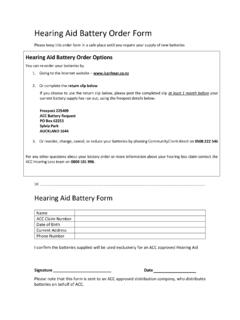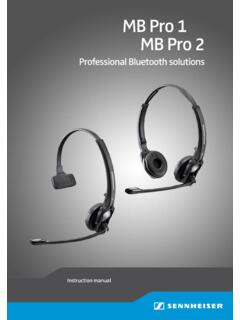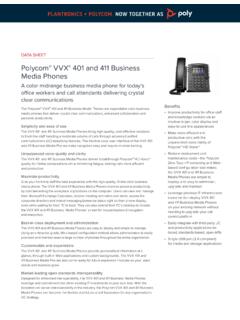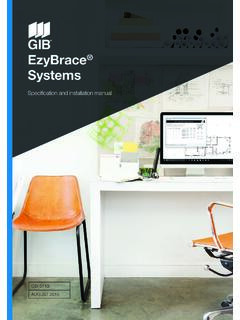Transcription of section 7 - ACC
1 191section 7 Contents Using equipment for moving and handling people Types of equipment Examples of moving and handling equipment Slide sheets Transfer belts Transfer boards Air assisted transfer devices Electric profiling beds Mobile hoists Standing hoists Ceiling hoists Gantry hoists Fixed wall hoists Slings Stretchers Wheelchairs Standing and pivoting aids (non electric) Shower and bath equipment Emergency equipment Other types of equipment and aids References and : All images and other references to equipment shown in this section are provided for illustrative purposes only.
2 They are not, and should not be taken as, endorsements of specific equipment or for moving and handling Using equipment for moving and handling peopleThis section describes the main types and functions of equipment for moving and handling people. section 8 of the Guidelines, Equipment management , covers equipment procurement systems, maintaining an equipment register and equipment storage, maintenance and is a core component in effective moving and handling programmes, together with risk assessments, the use of correct techniques, staff training and appropriate facility design.
3 The supply of equipment by itself will not lead to reduced rates of injury unless equipment use is part of a comprehensive moving and handling programme. Successful programmes provide both equipment and training in how to use specific items of equipment for lifting, transferring and repositioning proper use of equipment is essential for the safety of both clients and carers and improves the quality of client care. Equipment can also facilitate client rehabilitation, decrease morbidity and preserve the dignity of clients. Compared with techniques that involve manual transfers of clients without equipment, the use of equipment lessens the forces required for moving and handling clients and can reduce the and handling equipment also improves client outcomes, such as reducing their length of stay and the risk of complications such as deep vein thrombosis, chest infections, urinary tract infections, pressure ulcers, skin tears and fit for purpose equipment is one of the most important aspects of moving and handling programmes.
4 New moving and handling equipment is constantly being developed. With the increasing complexity of equipment and technological developments, information about specific equipment can become outdated. Managers responsible for purchasing equipment, and people providing training in equipment use, need to keep up to date with developments in equipment for moving and handling people. The primary focus of this section is on descriptions of equipment and specific features. Specific procedures for using equipment, such as slide sheets, slings and hoists, are described in section 4 Techniques for moving and handling 7: equipment for moving and handling Types of equipmentTable shows the main types of equipment used for moving people, and examples of common uses.
5 Some types of equipment are known by several names, as shown. Detailed descriptions of each type of equipment are provided later in this section . For some categories of equipment, there are several related types, which may have different Common types of equipmentType of equipment(and alternative names)Description and common usesSlide sheet(sliding sheet, slippery sam)A sheet made of low friction material and used under a client to allow easy repositioning in bed, sling attachment and lateral transfersTransfer belt( handling belt, gait belt, walking belt)A belt placed around a client s waist during several types of transfer and for assisted walking for rehabilitation.
6 There are multiple types of beltTransfer board(PAT slide, slide board, banana board)A full body length board made from wood or plastic, used to bridge gaps for client transfers from one surface to another, such as from a stretcher or wheelchair to a bed. Smaller transfer boards can also be used for lateral, seated to seated transfersAir assisted transfer deviceThere are several types: inflatable mattresses for lateral (bed to bed) transfers and air assisted lifting devices or jacks Electric profiling bed(electric bed)An electrically operated bed that has a mattress platform split into two, three or four sections, which allows adjustment using a control handset or panelMobile hoist(floor hoist, floor lift, mechanical lift, portable hoist)A hoist with wheels that can be moved along the floor used for lifting a client inside a sling or on a stretcher designed for use with hoistsStanding hoist(sit to stand hoist, standing lift, stand aid hoist)
7 A specific type of mobile hoist designed to assist people between sitting and standing positions. Standing hoists are designed to fit under and around chairsCeiling hoist(overhead hoist, ceiling lift, mechanical lift, gantry hoist)A hoist attached to permanently mounted ceiling track that moves a client inside a sling. Gantry hoists have overhead tracks mounted on wheeled framesSlingA fabric support used for carrying a client while being moved with a hoist there are multiple types of slingStretcherA rigid frame used to carry a client in a lying or supine position. Often made of lightweight material and commonly used in ambulances and by emergency services.
8 Wheeled stretchers are used in hospitals for transporting clients between locations, and should be electricWheelchairA mobile chair used for transporting a client in a sitting or upright position. Bariatric wheelchairs must be powered or moved with bed pushers194 The main types of equipment that are commonly used can be summarised within the four main groups of client moving and handling tasks. These groups of tasks are: Sitting, standing and walking Bed mobility Lateral transfers provides a summary of the common types of equipment used for these handling tasks. The recommended techniques for each of tasks in the table below are described in section 5 of the handling tasks for which equipment may be usedType of taskExamples of specific movementsExamples of equipment that could be usedSitting, standing and walkingSitting to standing from a chairTransfer belt, standing hoist, mobile hoist, chair lifterStanding to sitting on a bedTransfer beltAssisted walkingTransfer belt, walker, gutter frame, hoist with walking harnessBed mobilityTurning in bedSlide sheets, electric bed with turning functionSliding client up in bedSlide sheets.
9 Electric bedSitting person up onto edge of bedSlide sheets, electric bed, bed accessoriesLateral transfersLateral transfer from bed to stretcherSlide sheets, transfer board, air mattress, standing hoistTransferring from chair to commodeCeiling hoist, mobile hoist, seated transfer board, standing hoistTransferring to toiletCeiling hoist, mobile hoistHoistingFitting a sling to client in bedSlingHoisting from bed to chairCeiling hoist, mobile hoist, standing hoistHoisting client from floorCeiling hoist, mobile hoist, air jackTransferring to toiletCeiling hoist, mobile hoist, standing hoist195 section 7: equipment for moving and handling Examples of moving and handling equipmentThe next part of this section provides examples of the more commonly used types of equipment for client handling .
10 Further information about specific types and functions of equipment can be obtained from the websites shown at the end of this section , and from companies supplying healthcare equipment in new zealand and Australia. Training in proper use is essential for all types of sheetsSlide sheets are one of the most commonly used types of equipment in healthcare services. They are used to move clients horizontally on beds, trolleys and chairs without lifting. Slide sheets are relatively low cost, have many uses and are relatively simple to use. They avoid the need to lift clients, but despite their simplicity they do require training in their proper is important that the use of slide sheets is consistent with current best practice, as described in section 4 Techniques for moving and handling people.


















